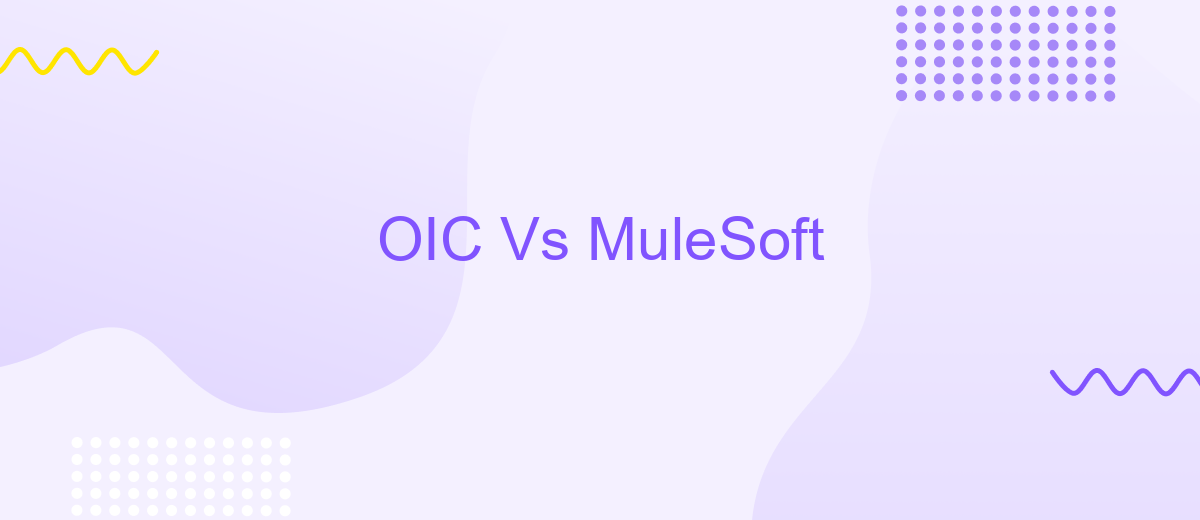OIC Vs MuleSoft
In today's rapidly evolving digital landscape, integration platforms like Oracle Integration Cloud (OIC) and MuleSoft have become essential tools for businesses seeking seamless connectivity and streamlined operations. This article delves into a comparative analysis of OIC and MuleSoft, exploring their features, capabilities, and use cases to help organizations determine which platform best aligns with their integration needs and strategic goals.
Introduction
In today's rapidly evolving technological landscape, businesses are increasingly relying on integration platforms to connect various applications and streamline operations. Two prominent players in this field are Oracle Integration Cloud (OIC) and MuleSoft. Both platforms offer robust tools for integrating applications, automating workflows, and enhancing data connectivity. However, choosing the right platform can be a daunting task, as each has its unique strengths and weaknesses.
- Oracle Integration Cloud (OIC): Known for its comprehensive suite of pre-built adapters and deep integration with other Oracle products.
- MuleSoft: Renowned for its flexibility, extensive API management capabilities, and strong community support.
Both OIC and MuleSoft aim to simplify the integration process, but they cater to different business needs and technical environments. For instance, platforms like ApiX-Drive offer additional integration solutions that can complement these major players by providing easy-to-use, no-code integration capabilities. Understanding the specific requirements of your organization will be crucial in making an informed decision between OIC and MuleSoft.
Key Differences

One of the key differences between OIC (Oracle Integration Cloud) and MuleSoft lies in their integration capabilities and user interface. OIC provides a more user-friendly interface with pre-built integrations and a drag-and-drop feature that simplifies the process for non-technical users. MuleSoft, on the other hand, offers a more robust and customizable platform, which is ideal for developers who need to create complex integrations from scratch. Both platforms support a wide range of connectors, but MuleSoft’s extensive library and API management capabilities give it an edge in versatility.
Another significant difference is in their pricing and scalability. OIC typically offers a more straightforward pricing model, which can be more predictable for budgeting purposes. MuleSoft’s pricing can be more complex due to its feature-rich offerings and tiered service levels. However, when it comes to scalability, MuleSoft’s architecture is designed to handle large-scale, enterprise-level integrations more efficiently. Tools like ApiX-Drive can also be considered for simpler, cost-effective integration solutions, providing a middle ground between the comprehensive capabilities of MuleSoft and the user-friendly nature of OIC.
Advantages of OIC

Oracle Integration Cloud (OIC) offers a robust suite of tools designed to streamline and enhance the integration process across different systems and applications. It stands out by providing a user-friendly interface and a comprehensive set of pre-built adapters that simplify the integration process.
- Ease of Use: OIC's intuitive drag-and-drop interface makes it accessible for users with varying technical expertise, reducing the learning curve and speeding up deployment.
- Scalability: The platform supports both small-scale and enterprise-level integrations, ensuring that it can grow alongside your business needs.
- Pre-Built Adapters: OIC comes with a wide range of pre-built adapters for popular applications, significantly reducing the time required for integration.
- Real-Time Analytics: It offers robust monitoring and analytics tools that provide real-time insights into your integrations, helping you to quickly identify and resolve issues.
- Security: OIC ensures secure data transfer with built-in security features, including encryption and compliance with industry standards.
Additionally, services like ApiX-Drive can complement OIC by offering specialized integration capabilities, allowing businesses to automate workflows and synchronize data across various platforms seamlessly. This combination can significantly enhance operational efficiency and data accuracy.
Advantages of MuleSoft

MuleSoft offers a robust and versatile integration platform that enables businesses to connect their applications, data, and devices seamlessly. One of the key advantages of MuleSoft is its ability to handle complex integration scenarios with ease, making it suitable for enterprises of all sizes. The platform is designed to be highly scalable and flexible, allowing organizations to adapt to changing business needs quickly.
Another significant benefit of MuleSoft is its user-friendly interface, which simplifies the process of creating and managing integrations. This is particularly valuable for teams that may not have extensive technical expertise. Additionally, MuleSoft provides a wide range of pre-built connectors and templates, which can significantly reduce the time and effort required to set up integrations.
- Comprehensive API management capabilities
- High scalability and flexibility
- Extensive library of pre-built connectors
- User-friendly interface
- Strong community support and resources
For businesses looking to further streamline their integration processes, services like ApiX-Drive can complement MuleSoft by offering additional automation and integration capabilities. ApiX-Drive provides an easy-to-use platform for setting up integrations between various applications, enhancing the overall efficiency and effectiveness of your integration strategy.
Conclusion
In conclusion, both OIC and MuleSoft offer robust solutions for integrating various applications and data sources, each with its unique strengths. OIC provides a more user-friendly experience with its pre-built integrations and simplified interface, making it an excellent choice for businesses looking for quick and easy deployment. On the other hand, MuleSoft excels in flexibility and scalability, ideal for enterprises with complex integration needs and a requirement for extensive customization.
When choosing between OIC and MuleSoft, it is essential to consider your organization's specific requirements, such as ease of use, scalability, and customization capabilities. Additionally, leveraging services like ApiX-Drive can further streamline the integration process, offering a versatile platform to connect various applications effortlessly. Ultimately, the right choice will depend on your business's unique needs and long-term goals.


FAQ
What is the primary difference between OIC and MuleSoft?
Which platform is more user-friendly for non-developers?
How do OIC and MuleSoft handle API management?
Can both platforms be used for real-time data integration?
What are the options for automating integrations in OIC and MuleSoft?
Apix-Drive is a simple and efficient system connector that will help you automate routine tasks and optimize business processes. You can save time and money, direct these resources to more important purposes. Test ApiX-Drive and make sure that this tool will relieve your employees and after 5 minutes of settings your business will start working faster.

